Aaron Hackmann was happy to see the sun shining today from his new “lakeside property” in Chamois, Missouri.
“We’re going to go for a boat ride here in a little while and take some pictures of pivots and kind of have some proof of insurance so to speak,” Hackmann said in good spirits, after experiencing a week of heavy downpour and historic flooding.
Hackman and his brother farm about 1,700 acres of corn and soybeans in the Missouri River bottom. They had a pretty good start to #Plant17, with over 800 acres of corn planted in about five days. Some of the crop was even about 4 inches tall. Then the rain started.
Now Hackmann says they probably have only about 50 acres left.
But Hackman said they know the drill. After a flood in 1993, the family moved their homes to higher ground and now have things streamlined to get everything up and moved out within a day’s time.
“We’ve went through a couple decades here — where I was 12 or 13 when that took place — so I kind of know the drill and helped move things out, but there are a few farmers in the bottom here that have never witnessed these things before,” Hackmann said.
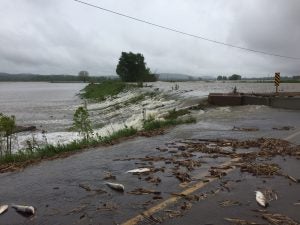
Jarrod Simpson and his dad, Bobby, run about 600 cow/calf pairs across five farms near Salem, Missouri. While they didn’t lose any cattle to the floodwaters, the family’s two farms west of Salem — 10 miles downstream on the Dry Fork — is where they saw the most damage.
The farms have at least a quarter- to half-mile of fence laying on the ground right now. On another farm upstream, Simpson hasn’t even been there yet to assess the damage, but imagines it will be about the same.
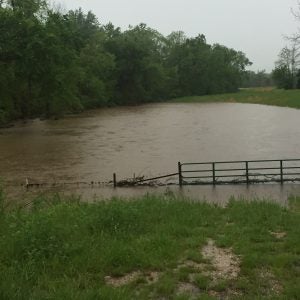
“On all our various farms, it seems like we got about 60 places where fences cross these drainages, these creeks, these rivers and it seems like about 95 percent of those water gaps are washed out right now so I’m in the process of fixing all of those,” Simpson said.
On their two farms west of town, the 33-year-old farmer said the water levels on the fence posts were the highest he has ever seen … even higher than the record levels in December 2015.
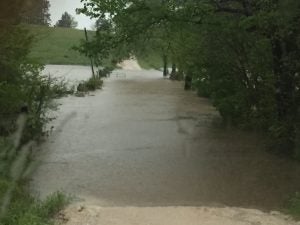
“It’s not an every year deal, but it seems like we get these every once in a while,” Simpson said. “This is one where the Meramec got out on the banks on us. It’s one of those deals where we get four to five inches in an hour but this kind of got spread out. With the Dry Fork, it was probably, for me, the highest it’s ever been.”
“It’s very devastating for those people that have land in those flood areas and it seems like the folks along the Gasconade and Meramac rivers just continually get flooded the last three or four years,” said Kelly Smith, Marketing and Commodities Director, Missouri Farm Bureau.
While Smith points out those two areas in particular, he said this time the flooding was much more widespread.
“Anybody along a tributary is affected this time around with the amount of rain we’ve got,” Smith said.
Located just west of the Mississippi River in Northeast Missouri, Lehenbauer Farms, Inc. is not totally flooded, just their bottomland. However, Amy Lehenbauer said their operation did have a nice stand of corn on over 1,000 acres that will likely have to replanted once the water is pumped off.
“When we get a lot of water quickly it is just difficult for the pumps to keep up and pump that water off quickly,” Lehenbauer said. “So once the water is pumped off we will have to assess the crop situation to see what it looks like and if we have a good enough stand to leave it or to see if we need to replant. The way it looks now we are likely going to have to replant that corn.”
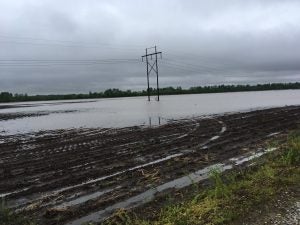
The fourth generation, diversified family farm had about two weeks of extremely wet weather off and on, but last week was when it really poured, according to Lehenbauer. Prior to that, they had extremely dry weather so they were able to get in the field in a timely manner, but it was becoming a concern because the ground was pretty dry.
“As always, we are at the mercy of the weather so there’s swings of dryness and wetness,” Lehenbauer said. “We needed the rain but probably not this much this quickly.”
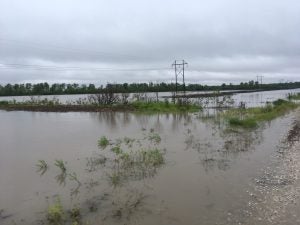
The downpour couldn’t have come at a worse time for both row-crop growers and livestock producers in Missouri and Arkansas.
“Unfortunately, these storms caught both livestock and row-crop farmers at a very critical time,” said Randy Veach, president of the Arkansas Farm Bureau. “We have livestock farmers who have lost cattle in the floods, miles of fencing has been washed away and there are many rural roads and bridges that are impassable.
“And for the row-crop farmers, this will be a big blow, as much of the rice and corn had already been planted. What happens with rain the rest of this week, and how existing floodwaters are managed by the Corps of Engineers, will determine just how big a problem this could be.”
Veach said these water-levels seem similar to the 2011 flooding, when 63 counties were declared disaster areas and more than 1 million acres were under water. The losses to Arkansas agriculture from the 2011 floods were estimated around $500 million.
“This has the potential to match the damages seen in 2011,” Veach said.
Missouri State Treasurer Eric Schmitt has activated a disaster relief program for Missouri small businesses and farms impacted by the flooding. The Harmed-area Emergency Loan Priority system, or HELP, authorizes 24-hour approval of support for low-interest loans obtained through participating lenders.
“Flood damage can be a significant financial setback for small businesses and farms, which are the backbone of Missouri’s economy,” said Schmitt. “My team is working hard to ensure those impacted by this weekend’s flooding can affordably finance water removal, restoration, and reconstruction.”
On Thursday, U.S. Secretary of Agriculture Sonny Perdue pledged the full resources and support of the USDA in response to severe flooding occurring in many states across the center of the country. Perdue issued the following statement:
“The people of the American agriculture community are made of hardy stock and can withstand their fair share of hardship, but just the same, they should know that their USDA stands with them during this natural calamity. We have seen levee breaks and flooding in the wake of storms, some of which have caused the loss of life, and USDA is ready to assist in any way we can. We have USDA employees in every county in this nation, and our people will be visible as they work to support people battling the flooding. As always, our thoughts and prayers are with our agriculture community, but our resources will be with them too.”



